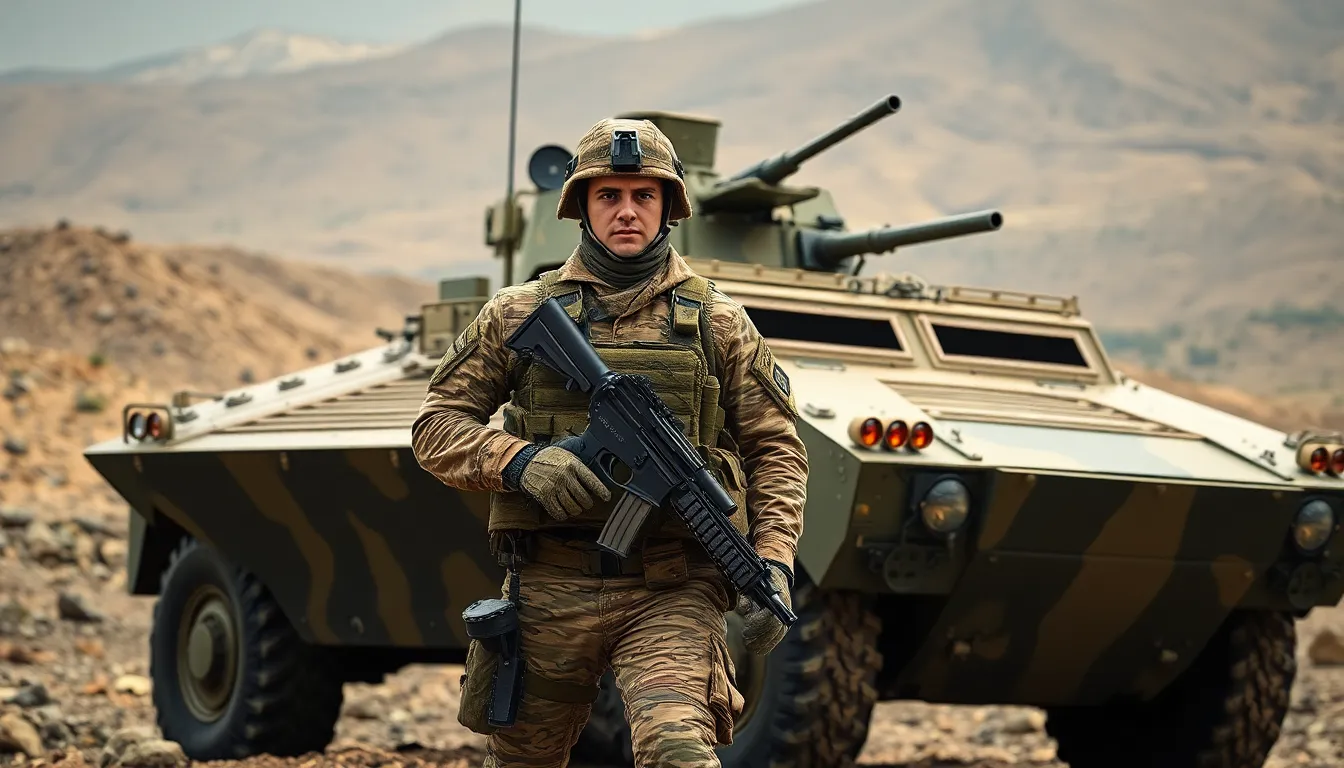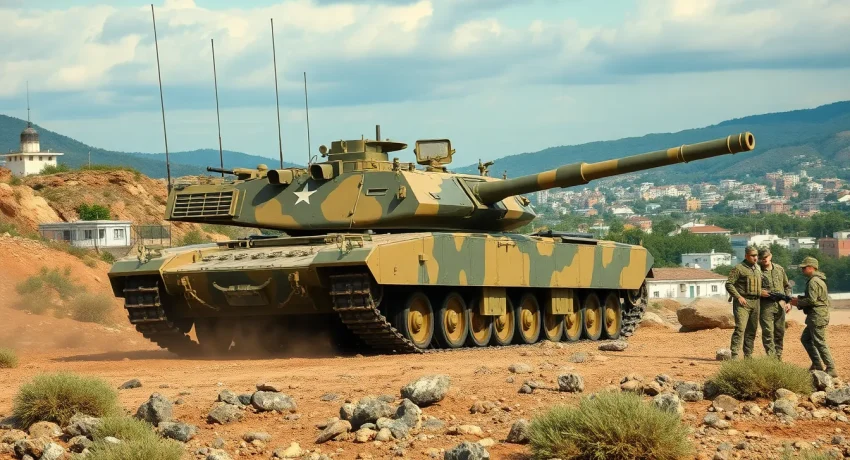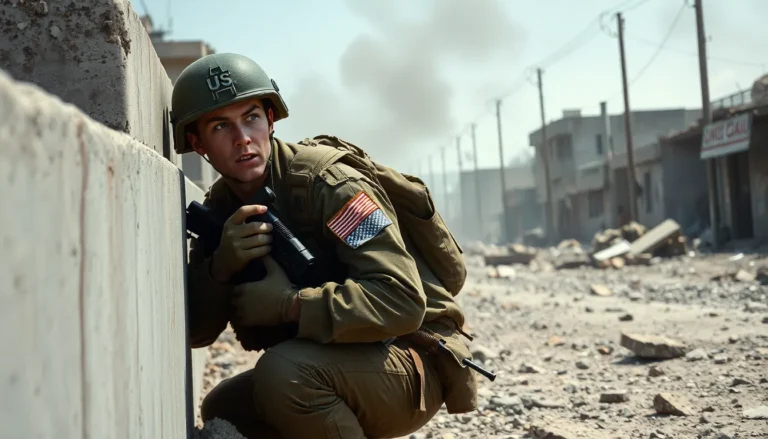In the high-octane world of military operations, battlefield vehicles are the unsung heroes that turn the tide of war. From hulking tanks that could probably crush a small house to nimble armored vehicles that zip around like they’re in a high-speed chase, these machines are more than just metal boxes on wheels. They’re the ultimate blend of power, technology, and a dash of sheer intimidation.
Table of Contents
ToggleOverview of Battlefield Vehicles
Battlefield vehicles encompass various types of military equipment designed for combat and support roles. Tanks stand out as one of the most recognized battlefield vehicles due to their armor and firepower. These units provide frontline strength, capable of withstanding enemy fire while delivering significant damage.
Armored personnel carriers (APCs) play a vital role in troop transport and protection. Their design allows for safe movement of soldiers across dangerous terrain. Each APC protects its occupants while ensuring quick deployment during operations.
Many forces utilize infantry fighting vehicles (IFVs) for both troop transport and direct combat. Equipped with heavier weaponry than APCs, IFVs enable infantry to engage enemy units effectively while remaining mobile. Additionally, reconnaissance vehicles gather intelligence crucial for strategic planning. Their agility and advanced surveillance systems enhance situational awareness during missions.
Logistics vehicles support battlefield operations by transporting supplies and equipment. These vehicles maintain essential supply lines, ensuring troops receive necessary resources. Heavy equipment transporters (HETs) specifically move larger vehicles and artillery, facilitating maintenance and operational readiness.
Unmanned ground vehicles (UGVs) introduce technological advancements to modern warfare. These robotic systems conduct reconnaissance, explosive disposal, and even combat roles, reducing risk to personnel. By integrating UGVs, forces enhance their operational efficiency and effectiveness on the battlefield.
Overall, battlefield vehicles, ranging from tanks and APCs to UGVs, form the backbone of modern military capabilities. Each type serves a specific purpose, collaborating to achieve mission objectives effectively.
Types of Battlefield Vehicles

Battlefield vehicles play distinct roles in military operations, each designed to meet specific combat and support needs.
Armored Combat Vehicles
Armored combat vehicles (ACVs) are engineered to provide robust protection while maintaining mobility. These vehicles often support infantry by offering cover during attacks. ACVs include vehicles like armored personnel carriers (APCs) and infantry fighting vehicles (IFVs), blending transport functions with combat capabilities. The advanced armor shields troops from small arms fire and shrapnel. Some models come equipped with weaponry capable of engaging enemy forces directly. Enhanced communication systems improve coordination on the battlefield. In scenarios requiring troop mobility under fire, ACVs become invaluable assets.
Infantry Fighting Vehicles
Infantry fighting vehicles (IFVs) combine troop transport with direct fire capabilities. These vehicles typically carry a squad of soldiers while providing support through integrated weapons systems. Notably, IFVs are designed to engage enemy forces while simultaneously protecting soldiers inside. Armor plating offers defense against small caliber weapons and shell fragments. Some versions feature an auto-cannon or anti-tank missiles for enhanced firepower. The versatility of IFVs complements traditional tanks by supporting infantry movements and engaging targets. Their presence on the battlefield improves overall tactical effectiveness.
Tanks
Tanks serve as the backbone of armored warfare, recognized for their heavy armor and formidable weaponry. These vehicles excel in frontline engagements, capable of taking substantial damage while delivering powerful strikes. Modern tanks feature advanced targeting systems, ensuring precision in combat. Equipped with cannons and machine guns, tanks can suppress enemy positions effectively. Mobility remains a key advantage, allowing tanks to traverse diverse terrains. Innovations like reactive armor enhance survivability against anti-tank weapons. Each tank in a regiment typically fulfills a crucial role in achieving dominance over adversaries.
Technology in Battlefield Vehicles
Recent advancements in technology have transformed battlefield vehicles into sophisticated machines, enhancing their combat capabilities and operational effectiveness.
Armament and Defense Systems
Armament plays a crucial role in battlefield vehicles. Tanks utilize powerful cannons and machine guns, allowing them to engage various enemy threats effectively. Armored personnel carriers (APCs) often feature medium-caliber weapons, providing defensive fire support while transporting troops. Infantry fighting vehicles (IFVs) stand out due to their advanced weapon systems, combining anti-tank missiles and automatic cannons for versatility. Defense systems integrated into these vehicles include reactive armor and electronic countermeasures, increasing their survivability against modern threats. Unmanned ground vehicles (UGVs) might use lightweight weapons and sensors for reconnaissance. These technologies collectively enhance battlefield vehicles’ ability to dominate combat scenarios decisively.
Mobility and Terrain Adaptability
Mobility significantly enables battlefield vehicles to navigate challenging terrains. Tanks, designed for various environments, possess excellent cross-country capabilities, allowing them to operate effectively on rugged landscapes. APCs excel in ferrying troops across difficult terrain while maintaining speed and stability. IFVs combine the strengths of transports and combat vehicles, showcasing adaptability during engagements. A notable feature of modern battlefield vehicles is the incorporation of advanced suspension systems, enhancing maneuverability in diverse conditions. UGVs present a unique flexibility, capable of traversing rough and urban landscapes with ease. This adaptability proves vital for mission success, enabling forces to respond rapidly to dynamic battlefield situations.
Historical Importance of Battlefield Vehicles
Battlefield vehicles have transformed military operations significantly throughout history. Their strategic value in conflicts cannot be understated.
Major Conflicts and Innovations
World War I marked the introduction of tanks, showcasing their ability to break through trenches and alter warfare. Innovations like the German Panzer and British Mark I set standards during World War II, where tanks dominated the battlefield. The Gulf War further highlighted advancements in precision weaponry and armored technology, making high-tech tanks pivotal in combat scenarios. These vehicles evolved continually, incorporating better armor and firepower to address enemy threats. Each conflict prompted upgrades, driving innovation in battlefield vehicle design and capabilities.
Evolution Over the Decades
The evolution of battlefield vehicles spans several decades, illustrating remarkable technological advances. In the 1940s, armored vehicles prioritized brute force. By the 1980s, focus shifted to speed and agility with vehicles like the Humvee, emphasizing quick troop movement. The introduction of unmanned ground vehicles in the early 21st century represented a leap toward automation. Contemporary designs incorporate advanced sensors and targeting systems, enhancing situational awareness. Coupled with improved mobility features, these vehicles navigate diverse terrains effectively, reflecting an ongoing commitment to enhancing operational capabilities in modern warfare.
Future Trends in Battlefield Vehicles
Technological advancements are reshaping battlefield vehicles, emphasizing automation and enhanced capabilities. Unmanned aerial vehicles (UAVs) are gaining prominence for reconnaissance missions, equipped with high-resolution cameras and advanced sensors. In addition, artificial intelligence (AI) is increasingly integrated into vehicle systems, improving decision-making and operational efficiency on the battlefield.
Electric and hybrid propulsion systems are becoming more commonplace, promoting sustainability and reducing logistical burdens associated with fuel supply. These systems allow for quieter operations, making stealth an essential factor in tactical situations. Cybersecurity measures are also gaining importance, as protecting vehicle communication networks becomes a priority to prevent enemy interference or sabotage.
Advanced materials, such as composite armor, are designed to provide superior protection while reducing overall weight. Light-weight armored vehicles benefit from enhanced mobility, allowing for rapid deployment in various terrains. Moreover, modular designs are on the rise, facilitating quick adaptability for different missions by changing equipment or configurations.
Collaboration between military and technology sectors is crucial in developing next-generation vehicles. Innovations fostered through public-private partnerships lead to breakthroughs in robotics and automation that redefine conventional combat scenarios. The focus on multi-domain operations further drives the evolution of battlefield vehicles, ensuring they meet the diverse challenges posed by modern warfare.
Lastly, emphasis on crew survivability persists, incorporating advanced situational awareness technologies like augmented reality displays. These technologies provide real-time data, enhancing tactical awareness and improving response times during combat. The evolution of battlefield vehicles continues, with a clear trajectory toward smarter, more versatile, and resilient military solutions.
Battlefield vehicles are essential to modern military operations. Their evolution reflects advancements in technology and strategy. From tanks that dominate the frontline to versatile UGVs that enhance safety and efficiency, each vehicle plays a distinct role in achieving mission success.
As warfare continues to evolve, so will the design and functionality of these vehicles. The integration of AI and automation promises to redefine operational capabilities. Future battlefield vehicles will not only enhance combat effectiveness but also prioritize crew safety and sustainability. This ongoing transformation ensures that military forces remain prepared to face emerging challenges on the battlefield.




